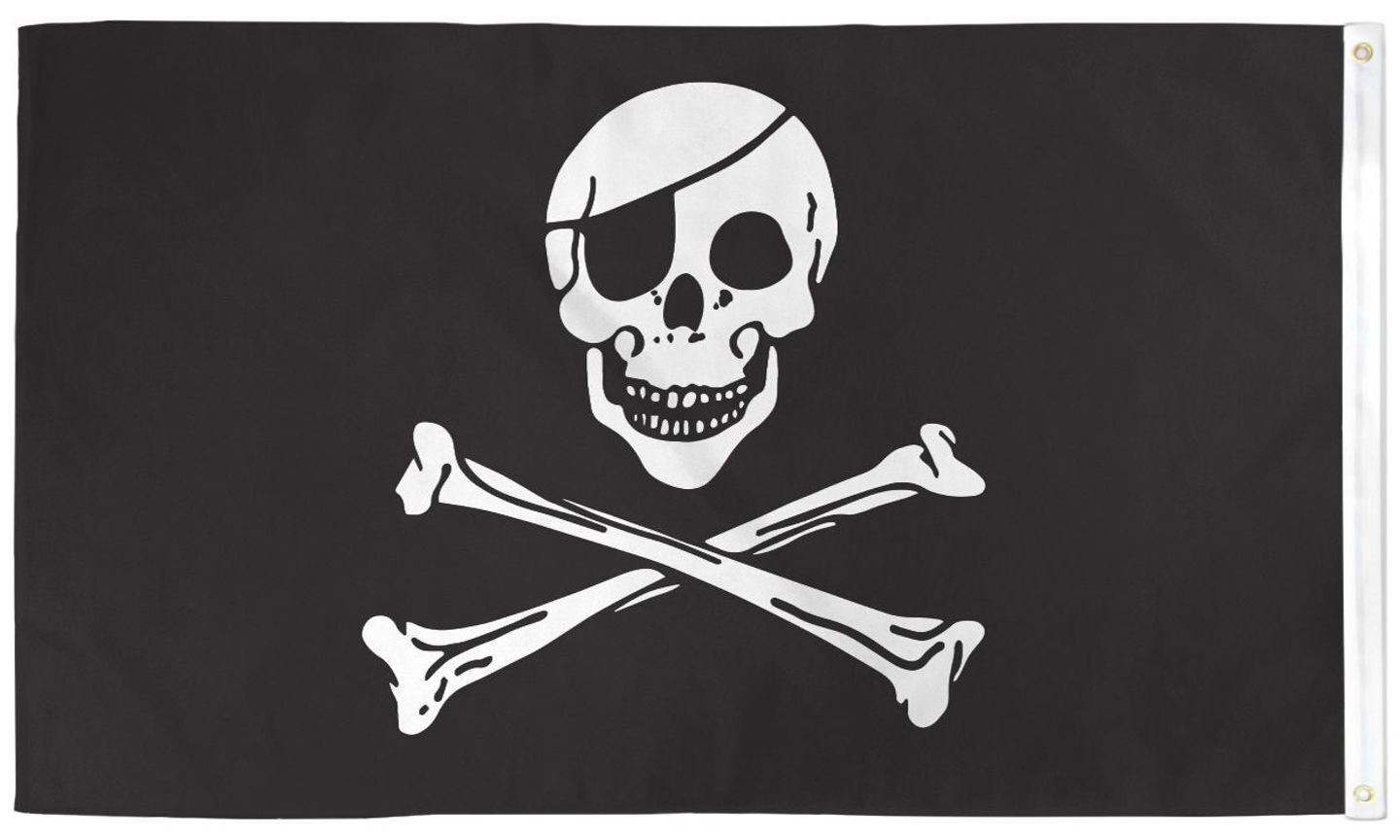
Ahoy, matey! Ever wondered about the Jolly Roger flag? This iconic symbol of piracy has a rich history filled with daring tales and hidden meanings. But what exactly is the Jolly Roger flag? It's the classic black flag with a white skull and crossbones, flown by pirates to strike fear into the hearts of their enemies. Used during the Golden Age of Piracy, it signaled that no mercy would be given. Pirates like Blackbeard and Calico Jack made it famous. Today, it’s a symbol of rebellion and adventure. Ready to dive into 35 intriguing facts about this legendary flag? Let's set sail!
Key Takeaways:
- The Jolly Roger flag, with its skull and crossbones design, was used by pirates to intimidate and signal their intent to attack, saving time and resources by causing merchant ships to surrender without a fight.
- Today, the Jolly Roger continues to be a powerful symbol, representing rebellion, fighting spirit, and nonconformity, and is used in various contexts from sports to fashion and activism.
The Origins of the Jolly Roger Flag
The Jolly Roger flag is one of the most iconic symbols associated with pirates. Its history is rich and fascinating, filled with tales of the high seas and daring adventures.
- The term "Jolly Roger" is believed to have originated from the French phrase "joli rouge," meaning "pretty red," referring to the red flags used by early pirates.
- Pirates used the Jolly Roger to signal their intent to attack, hoping to intimidate their targets into surrendering without a fight.
- The earliest known use of a pirate flag dates back to the early 18th century, around 1700.
- The classic design of the Jolly Roger, featuring a skull and crossbones, was popularized by pirate captains like Blackbeard and Calico Jack.
Design Variations of the Jolly Roger
While the skull and crossbones are the most recognized design, there were several variations of the Jolly Roger used by different pirate crews.
- Some Jolly Roger flags featured a full skeleton instead of just a skull and crossbones.
- Other designs included hourglasses, which symbolized that time was running out for the pirates' victims.
- Some flags depicted weapons like swords or spears, emphasizing the pirates' readiness for combat.
- Blackbeard's flag showed a skeleton holding an hourglass in one hand and a spear in the other, with a bleeding heart nearby.
Famous Pirates and Their Jolly Roger Flags
Many notorious pirates had their own unique versions of the Jolly Roger, each with its own distinct symbolism.
- Blackbeard's flag was meant to strike fear into the hearts of his enemies, with its menacing skeleton and bleeding heart.
- Calico Jack Rackham's flag featured a skull with crossed swords beneath it, symbolizing his crew's readiness for battle.
- Bartholomew Roberts, also known as Black Bart, used a flag showing himself standing on two skulls, representing the heads of his enemies.
- Edward Low's flag depicted a red skeleton, symbolizing blood and death.
The Purpose of the Jolly Roger
The Jolly Roger wasn't just for show; it served several practical purposes for pirates.
- Displaying the Jolly Roger often caused merchant ships to surrender without a fight, saving the pirates time and resources.
- The flag helped to establish the pirates' reputation, making future encounters more likely to end in surrender.
- Pirates used the Jolly Roger to distinguish themselves from privateers, who were authorized by governments to attack enemy ships.
- The flag also served as a warning to other ships that the pirates were ruthless and would show no mercy.
The Evolution of the Jolly Roger
Over time, the Jolly Roger has evolved and taken on new meanings in popular culture.
- In modern times, the Jolly Roger is often used as a symbol of rebellion and nonconformity.
- The flag has been adopted by various subcultures, including punk rock and hacker communities.
- The Jolly Roger is frequently featured in movies, books, and video games about pirates, helping to keep the legend alive.
- Some military units, particularly in naval forces, have adopted the Jolly Roger as a symbol of their fighting spirit.
Myths and Misconceptions about the Jolly Roger
Despite its iconic status, there are many myths and misconceptions about the Jolly Roger and its use by pirates.
- Contrary to popular belief, not all pirates used the Jolly Roger; some preferred plain black or red flags.
- The idea that pirates buried their treasure and marked the spot with a Jolly Roger is largely a myth.
- The Jolly Roger was not always flown during attacks; pirates often used false flags to get close to their targets before raising the Jolly Roger.
- The notion that the Jolly Roger was universally recognized and feared is an exaggeration; its impact varied depending on the region and the time period.
The Jolly Roger in Modern Times
Today, the Jolly Roger continues to be a powerful symbol, representing various ideas and movements.
- The flag is often used by sports teams and fans to symbolize their fighting spirit and determination.
- Some environmental and activist groups use the Jolly Roger to represent their fight against perceived injustices.
- The Jolly Roger is a popular motif in fashion, appearing on clothing, accessories, and tattoos.
- The flag is also used in marketing and branding, particularly for products and services that want to convey a sense of adventure and danger.
Fun Facts about the Jolly Roger
Here are some additional interesting tidbits about the Jolly Roger and its place in history and culture.
- The Jolly Roger has been featured in numerous works of fiction, including Robert Louis Stevenson's "Treasure Island" and the "Pirates of the Caribbean" film series.
- Some historians believe that the Jolly Roger's skull and crossbones design was inspired by the symbols used by the Knights Templar.
- The flag has been used in various forms of protest, including by anti-establishment groups and political movements.
- The Jolly Roger is often associated with Halloween and pirate-themed parties, adding a touch of spooky fun to the festivities.
- In some cultures, the Jolly Roger is seen as a symbol of freedom and independence, representing the pirates' rejection of authority and societal norms.
- The flag has been used in various military contexts, including by submarines and special forces units, to symbolize their stealth and deadly capabilities.
- The Jolly Roger remains a popular subject for artists and designers, inspiring countless interpretations and adaptations.
The Legacy of the Jolly Roger
The Jolly Roger flag isn't just a symbol of piracy; it's a piece of history that tells tales of adventure, rebellion, and the high seas. From its origins in the 18th century to its portrayal in popular culture, this flag has captured imaginations for centuries. Pirates used it to strike fear into their enemies, but today, it represents a fascinating chapter of maritime lore. Whether you're a history buff or just curious about pirate legends, the Jolly Roger offers a glimpse into a world of daring escapades and lawless freedom. Next time you see that skull and crossbones, remember the stories and the real-life figures who once sailed under its banner. The Jolly Roger isn't just a flag; it's a symbol of a bygone era that continues to intrigue and inspire.
Frequently Asked Questions
Was this page helpful?
Our commitment to delivering trustworthy and engaging content is at the heart of what we do. Each fact on our site is contributed by real users like you, bringing a wealth of diverse insights and information. To ensure the highest standards of accuracy and reliability, our dedicated editors meticulously review each submission. This process guarantees that the facts we share are not only fascinating but also credible. Trust in our commitment to quality and authenticity as you explore and learn with us.


